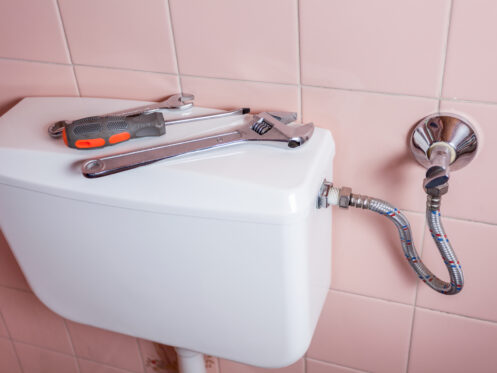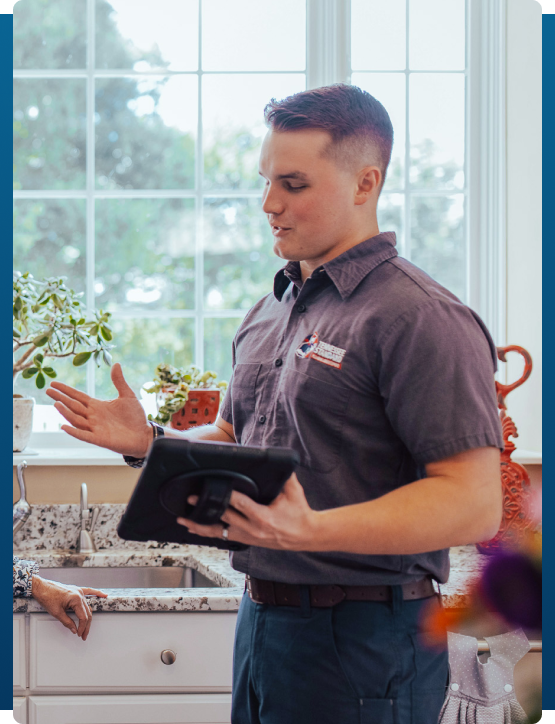Is there a puddle of water or water stains on your bathroom floor by your toilet? Or do you keep hearing continuous sounds of running water from your toilet? These could be signs that your toilet is leaking. A leaky toilet will rack up your water bills, compromise the structural integrity of your bathroom flooring, and put your family’s health at risk due to mold growth.
Here are five common reasons your toilet could be leaking when you flush it.
1. Damaged or Loose Flush Valve
When you flush the toilet, the flush valve is the part that releases water from the tank into the bowl. If this valve is loose or compromised, water will leak around its seal and trickle along the edges. This leakage might result in puddles near the connection points between the bowl and tank or at the toilet base, signaling an issue with the flushing system.
While these leaks may seem minor, they can worsen if left unfixed. The continuous dripping wastes water and poses a significant risk of damage to your toilet.
A defective flush valve also strains parts of your toilet system. Continuous water flow from a faulty flush valve promotes wear on components like the flapper and float mechanism, leading to expensive repairs in the future.
Addressing a faulty flush valve requires professional assistance to ensure proper repair or replacement. A plumber will check it and make adjustments, such as tightening the valve or swapping it out to avoid leaks.
2. Aged Toilet Flapper
The toilet flapper, also known as the flush valve seal, keeps the water inside the tank until you press the flush button. With time, the rubber material of the toilet flapper deteriorates because of constant flushing and contact with water. The deterioration will affect the flapper’s ability to keep the seal between the tank and the bowl tight. Gradually, due to the compromised seal, water will leak from the tank into the bowl, causing continuous water wastage and potential water damage issues.
How can you tell if the toilet flapper is old? The flapper may be old and defective if you hear a constant water flow in your toilet tank or if the tank takes longer than usual to fill. An aged flapper that cannot seal properly will allow water to leak from the tank into the toilet bowl.
Another sign is tiny rubber deposits in your toilet tank when you flush. A worn-out flapper starts to disintegrate after a long period of use, leaving small pieces of rubber in your tank. Also, your flapper may be ineffective if you notice more frequent clogs or incomplete flushes.
Like the inefficiencies caused by a faulty flush valve, a worn-out flapper also leads to water wastage that increases your water bills. It also accelerates the deterioration of other components, thus decreasing your toilet’s flushing efficiency.
Replacing an aged flapper is insufficient if other underlying problems are causing its wear. When addressing a worn-out flapper, contact a reliable plumber to assess the toilet’s flushing system. The expert will check different components, such as the flush valve and chain to identify the potential root of the leaks. They will then replace the flapper and ensure it is compatible with the other parts.
The professionals will use a durable, high-quality flapper in the valve seal to create a tight seal. They may also adjust the flapper chain length to improve flushing efficiency. This approach can save you money in reduced utility bills while maintaining your toilet system’s integrity for years.
3. Defective Wax Ring
The toilet wax ring is a malleable component that seals the toilet bowl to the sewer lines on the floor. They are gummy-like and extremely sticky to seal out air bubbles and prevent water drops from leaking when flushing.
Wax rings, however, can easily get ruined over time due to wear and tear or the toilet bowl shifting. A shifted toilet will make the wax rings dry or slip, causing leakage. Also, when the sewer line backs up into the toilet, the stagnant water erodes the waxy seal, thus ruining the wax rings. The first clue of a ruined wax ring is water leaking from the toilet base. Other signs include watermarks or unpleasant odors from the bottom of the toilet bowl. You should address these issues promptly to ensure comfort and top-notch hygiene.
The process of replacing the toilet wax ring is tedious and requires expertise. It entails disconnecting and resealing the toilet to create a watertight seal that prevents more leaks. A proficient plumber will start by removing the toilet parts and inspecting the flange and the wax ring for possible signs of damage. They will then replace the defective wax ring with a fitting wax ring size and type to guarantee compatibility with the sewer pipe and toilet. Once done with the replacement, the experts will skillfully reattach the toilet and test to check that the resealing was successful.
4. Broken or Cracked Bowl or Tank
Toilet tanks and bowls mostly consist of easy-to-break materials like ceramic and porcelain. Sometimes, when these materials crack, the damage may seem inconspicuous. However, these damages can slowly cause significant leakage and structural damage.
Toilet bowls and tanks develop cracks due to several factors. Firstly, your toilet bowl or tank experiences normal wear and tear during the years of use. Or, they can crack during repairs because of the delicate materials. For instance, you may attempt a DIY repair project and overtighten the bolts around the tank or set down the lid too hard, resulting in cracks.
When the bowl or tank fractures, it compromises the integrity of the toilet system, allowing water to leak when flushing. These leaks pose a significant risk of water damage to the bathroom floor. Long-term contact with moisture from the water damage also fosters mold and mildew growth, affecting your indoor air quality.
The solution to a cracked tank or bowl is hiring professional plumbers with the know-how and equipment to repair or replace them. But how do you decide when to repair or replace the toilet bowl or tank?
This decision depends on the type of crack you are dealing with. If you have a crack above the water level, you must constantly monitor its growth rate to determine when you may need a replacement. However, a crack below the water requires immediate repair to ensure minimal water loss. Ultimately, whether you need to replace or repair this type of crack depends on how much leakage you are dealing with and the crack size.
Consult a professional plumber to help you assess the damage and recommend whether to repair or replace your toilet tank or bowl.
5. High Water Pressure
If you have checked the flushing system apparatus and all seem to work fine, high water pressure could be causing the leakage. While toilets usually have standardized water pressure, sometimes fluctuations happen and increase this pressure, causing leaks when you flush the toilet.
High water pressure strains loose or non-insulated pipes, making them hammer against other pipes or the wall. The hammering can result in bursts and facilitate premature damage to internal components like the seal, flush valve, and flapper. In addition, this excessive force can worsen the cracks in the bowl or tank, causing leaks and water damage.
To address this inconvenience, hire a reputable plumber to do a detailed assessment of the plumbing system, including checking the water pressure level in your home. The expert may recommend installing a pressure-reducing valve if the pressure surpasses the optimal level. A PRV controls the water pressure in your home to a manageable level, protecting your fixtures, like the toilet, from water pressure damage. Professionals will ensure the PRV maintains consistent water pressure throughout your home, reducing the chances of leakage.
Contact Us Today
Do not let a leaking toilet ruin your day! At Tennessee Standard Plumbing, we can do more than fix your toilet. We also offer drain cleaning, leak repair, leak detection, and water treatment, among many other services. Our reliable and reputable team provides quality service to clients in Knoxville, TN, and the surrounding areas. Contact us today to experience affordable professional plumbing services.


